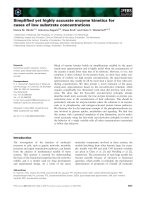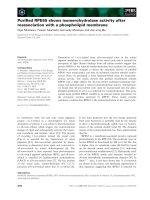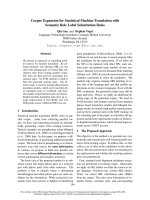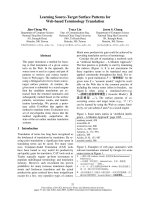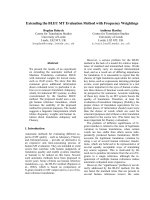Báo cáo khoa học: Modified merozoite surface protein-1 peptides with short alpha helical regions are associated with inducing protection against malaria docx
Bạn đang xem bản rút gọn của tài liệu. Xem và tải ngay bản đầy đủ của tài liệu tại đây (546.6 KB, 7 trang )
Modified merozoite surface protein-1 peptides with short alpha helical
regions are associated with inducing protection against malaria
Mary H. Torres
1
*, Luz M. Salazar
1
*, Magnolia Vanegas
1
, Fanny Guzman
1
, Raul Rodriguez
1
, Yolanda Silva
1
,
Jaiver Rosas
1
and Manuel E. Patarroyo
1,2
1
Fundacion Instituto de Inmunologı
´
a de Colombia (FIDIC), Bogota
´
, Colombia;
2
Universidad Nacional de Colombia,
Bogota
´
, Colombia
The merozoite surface protein-1 represents a prime candi-
date for development of a malaria vaccine. Merozoite sur-
face protein-1 has been shown to demonstrate high-activity
peptide binding to human red blood cells. One of the
high-activity binding peptides, named 5501, located in the
N-terminus (amino acid sequence MLNISQHQCVKKQ
CPQNS) of the 19-kDa molecular mass fragment of mero-
zoite surface protein-1, is conserved, nonimmunogenic and
nonprotective. Its critical binding residues were identified
and replaced with amino acids of similar mass but different
charge, in order to modify their immunogenic and protective
characteristics. Three analogues with positive or negative
immunological results were studied by nuclear magnetic
resonance to correlate their three-dimensional structure with
their biological functions. The studied peptides presented
a-helical fragments, but in different peptide regions and
extensions, except for randomly structured 5501. We show
that altering a few amino acids induced immunogenicity and
protectivity against experimental malaria and changed the
peptide three-dimensional structure, suggesting a better fit
with immune-system molecules.
Keywords: MSP-1 protein; peptide analogues; nuclear
magnetic resonance; vaccine candidate.
Multiple receptor–ligand type interactions are involved in
the host-cell invasion process of the Plasmodium falciparum
malaria parasite [1–3], allowing the entry and survival of this
deadly parasite. More than 250 million people are infected
with P. falciparum annually, and more than 2.5 million die;
of these, the majority are children < 5 years-old, most of
them in sub-Saharan Africa [4].
Our goal was to induce protective immune responses
capable of blocking the receptor–ligand interactions, as a
strategy for developing vaccines that could be used to
impede invasion, inhibit infection and thus decrease the
heavy burden that this disease imposes on mankind.
One of the most studied proteins of P. falciparum (and a
prime candidate for the development of a malarial vaccine)
is the merozoite surface protein-1 (MSP-1) [5]. This
molecule (synthesized as a 195–200 kDa molecular mass
precursor in the parasite’s schizont) is enzymatically pro-
cessed and cleaved into polypeptide fragments of 83 kDa,
38 kDa, 30 kDa and 42 kDa molecular mass. The 42 kDa
molecular mass fragment is further cleaved (in a Ca
2+
-
dependent process) into polypeptides of 33 kDa and
19 kDa molecular mass. The 19 kDa molecular mass
fragment is the only one that enters red blood cells (RBCs)
during invasion [6].
Urquiza et al. [1] and Rodriguez et al. [2] have developed
a specific methodology for identifying microbial peptide
receptor–ligand interactions with their host cells, via high-
activity binding peptides (HABPs), to determine which
MSP-1peptidesbindtoRBCs.
One of these HABPs, the conserved 5501 HABP located
in the N-terminus of the 19 kDa molecular mass fragment
(amino acid sequence 1629 M
LNISQHQCVKKQCPQNS
1646) has a 230-n
M
affinity constant (K
d
), 1.18 Hill
coefficient and a theoretical 11 800 ± 2300 number of
RBC receptor sites [1].
Conserved malarial peptides are poorly or nonantigenic,
and their respective HABPs are nonimmunogenic and
nonprotective [7–10]. The critical RBC-binding residues
(underlined above) were identified here by glycine-replace-
ment analogue scanning, as previously described [2,3]. These
critical residues were replaced with amino acids of similar
mass, but different charge, to render them immunogenic
andprotectiveintheAotus experimental model. The
objective of this work was to identify a correlation between
these modified HABPs and their 3D, as determined by
1
H-NMR.
Materials and methods
Peptide synthesis
The peptides were synthesized by using standard t-Boc
solid-phase peptide synthesis, previously described by
Merrifield and modified by Houghten [11], in polypropylene
bags with 150 mg of p-methylbenzhydrylamine resin HCl
Correspondence to M. E. Patarroyo, Fundacio
´
n Instituto de
Inmunologı
´
a de Colombia (FIDIC), Carrera 50, no. 26-00, Bogota
´
,
Colombia. Fax: + 57 1 4815269, Tel.: + 57 1 4815219,
E-mail:
Abbreviations: FITC, fluorescein isothiocyanate; HABP,
high-activity binding peptide; MSP-1, merozoite surface protein-1;
RBC, red blood cell; RMSD, root mean square deviation.
*Both authors contributed equally as first authors.
(Received 22 May 2003, revised 23 July 2003,
accepted 5 August 2003)
Eur. J. Biochem. 270, 3946–3952 (2003) Ó FEBS 2003 doi:10.1046/j.1432-1033.2003.03780.x
(Bachem, Torrance CA, USA). The resin was deprotonated
by adding 5% diisopropylethylamine (Merck) in methylene
chloride before introducing the first amino acid. The
coupling cycle was initiated by submerging the bags in a
solution containing equimolecular amounts of t-Boc amino
acid (Bachem-Peninsula, Torrance, CA, USA) and diiso-
propylcarbodiimide (Merck), in a 10-fold molar excess over
available amine in the bag. The reaction was allowed to
proceed for 60 min and the product was washed with
methylene chloride. The t-Boc groups of the newly coupled
amino acids were removed with 55% trifluoracetic acid
(Pierce, Rockford, IL, USA) in methylene chloride. Reac-
tion products were washed and amino groups deprotonated
with diisopropylethylamine. Asn and Gln coupling was
carried out by adding 1-hydroxy-benzotriazole hydrate
(Aldrich) in dimethylformamide.
Protected amino acids were liberated from the resin by
treatment with 2 mL of 10% anisole in anhydrous hydrogen
fluoride (Air Products, Allentown, PA, USA) for 60 min at
0 °C. The hydrogen fluoride was distilled from the reaction
and the product was washed five times with ethyl ether
(Merck). The peptides were subsequently extracted in 5%
acetic acid (Merck), and then analysed and purified by RP-
HPLC on an analytical Vydac C-18 column and a Vydac
preparative C-18 column by linear-gradient elution from 0 to
100% B with the following solvent system: A, H
2
Oand
0.05% trifluoroacetic acid; B, CH
3
CN and 0.05% trifluoro-
acetic acid for 45 min (45–60 min for preparative process) at
a1.0mLÆmin
)1
flow rate (4.5 mLÆmin
)1
for preparative
process). The polypeptide molecularmasses were determined
by MS (Bruker Protein MALDI-TOF spectrophotometer).
Peptide analogues (called polymers) were synthesized
with Cys-Gly in the C- and N-terminus of each peptide to
allow polymerization forming disulfide bond by an oxida-
tion reaction. This procedure has been carefully standard-
ized to guarantee the inclusion of high-molecular-mass
polymers for immunization purposes. The polymers were
analysed by size-exclusion chromatography; their molecular
masses ranged from 8 to 24 kDa.
Competition-binding assay
Critical amino acids were defined as being those amino acids
which, upon replacement with glycine, diminished erythro-
cyte-binding activity by > 50% of the original peptide
activity throughout the concentration range used. The role
of each HABP-5501 amino acid in erythrocyte binding was
determined by competition-binding assays between the
original radiolabelled peptide and nonlabelled original or
glycine analogue peptides, as described previously [2,3]. In
brief, 100 n
M
125
I-labelled HABP-5501 was incubated with
10
8
erythrocytes, in the presence or absence of 100 n
M
or
800 n
M
nonlabelled peptides, for 60 min at room tempera-
ture. Cells were then washed five times with isotonic
NaCl/P
i
; radioactivity associated with the cells was then
determined.
Animals and immunization
Aotus nancymaae monkeys were immunized with the
synthesized polymeric peptide analogues, shown in Table 1,
to induce humoral immune responses as well as protection
against experimental challenge with the P. falciparum
malaria parasite.
Spleen-intact Aotus monkeys, kept at our Primate
Station in Leticia (Colombia) in the Amazon region,
according to National Institutes of Health guidelines, were
analysed by the IFA test for the presence of P. falciparum
schizont parasite antibodies in their sera (a 1 : 20 dilution
of sera was used). The few Aotus monkeys testing positive
for the presence of P. falciparum schizont parasite anti-
bodies were returned to the jungle. The Aotus monkeys
testing negative for P. falciparum schizont parasite anti-
bodies were distributed in random groups of five or six for
immunization. Each monkey received, subcutaneously,
125 lg of the polymerized peptide homogenized in Fre-
und’s Complete Adjuvant for the first dose on day 0, and
homogenized in Freund’s Incomplete Adjuvant for the
second dose on day 20; most also received a third
immunization on day 40.
Blood was drawn for immunological analysis on days 0
and 15, and 20 days after each immunization.
Challenge and parasitemia assessment
Both immunized and control A. nancymaae monkeys were
infected with 200 000 P. falciparum FVO-strain infected
RBC, via the femoral vein, for challenge 20 days after the
last immunization [12]. Protection was defined as being the
total absence of parasites in blood during the 15 days of
the experiment. Nonprotected monkeys developed patent
parasitemia on days 5 or 6, reaching levels of ‡ 6% between
days 8 and 10. After receiving treatment with antimalarial
drugs in paediatric doses, they were quarantined to ensure
cure and subsequently returned to the jungle.
The parasitemia in individual monkeys was measured
daily, starting on day 5 after challenge. Immunofluorescence
was used to evaluate the number of parasites, in terms of the
percentage of parasitized RBC, on slides following Acridine
Orange staining.
IFA and Western blot
Late-stage schizonts from a continuous P. falciparum
culture (FCB-2 strain) were synchronized, according to
the method of Lambros & Vandenberg [13]. They were
washed and treated as described previously [12]. The slides
with the dry parasites were blocked for 10 min with 1%
nonfat milk and incubated for 30 min with appropriate
dilutions of monkey sera (starting at a dilution of 1 : 40) for
antibody analysis. Reactivity was observed by fluorescence
microscopy using the F(ab¢)
2
fragments from a 1 : 100-
diluted goat anti-(monkey IgG) fluorescein isothiocyanate
(FITC) conjugate. Preimmune sera from all monkeys were
used as negative controls.
The20%late-parasitemiaRBCswerewashedwithNaCl/
P
i
(pH 7.2) and lysed with 0.2% saponin (Merck) for
Western blot analysis. The parasite proteins were extracted
by using lysis buffer (1 m
M
phenylmethanesulfonyl fluoride,
1m
M
EDTA and 5% SDS) and the lysate was centrifuged
(25 000 g, 45 min). A 10% resolving gel was used for SDS/
PAGE. The ensuing product was transferred onto nitrocel-
lulose paper and incubated with 1 : 100 diluted preimmune
or immune sera for Western blot analysis. The reaction was
Ó FEBS 2003 Modified MSP-1 peptides protect against malaria (Eur. J. Biochem. 270) 3947
revealed with affinity-purified goat anti-(Aotus IgG) alkaline
phosphatase conjugate [14].
NMR
Samples for NMR were prepared by dissolving 7 mg of
peptide in 500 lL of dimethylsulfoxide-d
6
aprotic medium
because these peptides were not soluble in aqueous solution
or in trifluoroethanol, and recent studies have shown that
preferential conformations of peptides dissolved dimethyl-
sulfoxide are not destabilized [15,16]. All NMR spectra were
recorded on a Bruker DRX-600 spectrometer at 295 K.
The basic NMR structure determination protocol for all
peptides can be described as follows: proton spectra were
assigned by using DQF-COSY [17], TOCSY [18] and
NOESY [19]. The TOCSY and NOESY (400 ms mixing
time) spectra were first used to identify individual spin
systems (amino acids) and then stretches of amino acids
Table 1. Humoral immune response and protective efficacy induced by 5501-derived peptides in Aotus monkeys.
3948 M. H. Torres et al. (Eur. J. Biochem. 270) Ó FEBS 2003
within a given primary structure (sequential assignment)
and 3D structure. Chemical shifts were referenced to the
residual protonated dimethylsulfoxide signal, defining it as
being 2.49 p.p.m. The 2D NMR data were processed using
XWIN
-
NMR
software.
Structure calculations
Peptide structure was determined by Molecular Simulations
Inc. (
MSI
) software. Cross-peak volume was obtained by
integration using
FELIX
software on the NOESY spectrum
from which the interprotonic distances (constraints) had
been obtained.
NOESY peaks were classified as being strong, medium
or weak signals, according to their relative intensity;
these corresponded to 1.8–2.5 A
˚
, 2.5–3.5 A
˚
or 3.5–5.0 A
˚
interproton distances, respectively. Distance Geometry
(
DGII
) software was used to generate a family of 50
structures. These structures were refined by using simulated
annealing protocol with
DISCOVER
software in conditions
restricting experimental distance and angular constraints.
The calculations were repeated several times until a
structure having a minimum of distance and angle restraint
violations and the least root mean square deviation
(RMSD), respecting consensus least energy structure, was
obtained. Structures having reasonable geometry and few
violations were then selected.
Results and discussion
Peptide analysis
Peptide purity (as analyzed by HPLC with a C18 reverse-
phase analytical column and MS analysis) showed that all
synthesized monomers had one single peak and the expected
theoretical mass and were used for the structural analysis
(NMR and CD). CD spectra analysis of monomers and
polymers, at a concentration where these peptides were
soluble in water, showed similar structural conformation
(data not shown).
The peptides’ polymer form was used for immunization
studies.
Critical binding residue
Critical binding residues were considered as being those
where analogue peptide-binding activity decreased by
> 50% of native peptide-binding activity; these were: L2,
K11, Q13, C14, P15 and S18, as shown in Fig. 1. According
to these results, the interaction was located mainly at the
C-terminus of peptide 5501. Fine erythrocyte-binding
specificity was observed, as Q13 and C14 were critical
residues for erythrocyte binding, but Q8 and C9 were not.
Immunological and protection studies
Table 1 shows lead, nonimmunogenic, nonprotective pep-
tide 5501 becoming immunogenic and protective, or only
immunogenic, as a result of specific changes made in some
of its critical binding residues.
As reported previously [7–10], three groups of peptide
modifications were observed. These modifications induced
high antibody titres against experimental challenge in group
A (as assessed by IFA) and protected monkeys with three or
two doses. The experiment was repeated once more using
one peptide (24148) and eight monkeys, giving complete
protection in three of 16 monkeys (18% protective efficacy).
Group B (including peptide 23754) had modifications
that induced high antibody titres without protection.
The largest panel of modified peptides, grouped in C
(including peptide 24326), did not induce either antibodies
or protection.
A Western blot (Fig. 2) of immunized monkey sera,
taken 15 days after the second immunization, showed
monkeys with high antibody titres, but not protected
(such as sera 13466 and 23754), owing to the fact that
their antibodies had disappeared by day 20 and did not
reappear following the third immunization, perhaps as a
consequence of an anti-idiotypic phenomenon or short-
lived antibodies. These sera reacted strongly with
195 kDa, 140 kDa and 83 kDa molecular mass molecules
and weakly with the 42 kDa molecular mass molecule. By
contrast, monkeys with antibodies that persisted for
longer than 20 days (data not shown) and that were
protected with only two immunizations (such as those
immunized with peptide 24148), reacted strongly with
70 kDa and 42 kDa molecular mass molecules. This data
suggests that immunization with peptides having different
modifications induces antibodies that recognize different
protein structural configurations in the same molecule
during MSP-1 protein cleavage and processing. Only the
latter peptide analogue was associated with inducing
protection.
NMR structure determinations were performed on
immunogenic and completely protective peptide 24148,
immunogenic but not protective 23754, and nonimmuno-
genic, nonprotective 24326, to establish the relationship
Fig. 1. Identification of critical residues for erythrocyte binding. The
height of the bars is proportional to the erythrocyte-binding activity.
Analogue peptides with erythrocyte-binding activity that were < 50%
of the original peptide-binding activity were considered to be peptides
containing modified critical residues.
Ó FEBS 2003 Modified MSP-1 peptides protect against malaria (Eur. J. Biochem. 270) 3949
between relevant substitution analogue 3D structure and
the immunogenicity and protective efficacy elicited in the
experimental monkeys.
NMR assignments
Completed d
aN
sequential NOEs were generally found for
all peptides. Intraresidual signal intensity (which was greater
than that of the d
aN
sequential signal) and the presence of
strong d
NN
cross-peaks, indicated that there was a signifi-
cant population of conformations in the a region of the /w
space.
The presence of NOEs between P15 d protons and T14
a proton for peptides 24148 and 24326, and V14 a proton
for peptide 23754, indicated that these peptides were trans
isomers.
The NOESY spectra of all peptides showed aN(i,i+1)
sequence signals to be stronger than intraresidue cross-
peaks. In addition to these sequential cross-peaks, some
medium-range d
NN
(i,i +1),d
ab
(i,i +3),d
aN
(i,i +3),
and d
aN
(i,i + 4) cross-peaks were found, indicating the
presence of typical helical fragments in all peptides included
in this study (except for 5501 that had a totally extended
form owing to the absence of medium-range signals, thus
making it impossible to determine its 3D structure). Peptides
24148, 23754 and 24326 sequential medium-range NOEs
are summarized in Table 2.
Molecular dynamics calculations
A set of 50 independently generated structures were
obtained, satisfying the experimental constraints when using
162 distance restraints (including short-range and medium-
range) and 16 x-dihedral angle restraints. A family of 28
low-energy conformers, which did not have a distance
violation larger than 0.40 A
˚
or dihedral angle violation
greater than 2°, were accepted. These structures had a
0.45-A
˚
RMSD superimposition value for the backbone
atoms. Structures were helical between residues S5 and V10
for peptide 24148. New calculations were performed for this
peptide, using 1.8-A
˚
lower-distance limits on all bins; 22
overlapped structures were found to have 0.19 A
˚
RMSD
and lesser violation (0.30 A
˚
), confirming previous results
(this and other analogue results are presented in Table 3).
According to Kabasch & Sander [20], all peptides have
well-defined helical structures.
Results of structure calculations for peptides 24326 and
23754 are also shown in Table 3.
It can be seen in Fig. 3 that immunogenic, protective
peptide 24148 presents a helical fragment between residues
5 and 10, maintaining great flexibility in the rest of the
molecule. Immunogenic, nonprotective peptide 23754
Fig. 2. Western blot analysis of solubilized antigens obtained from late
Plasmodium falc iparum schizonts.
Table 2. Summary of sequential medium range NOE connectivities
represented by different line thickness for peptides 24148, 24326 and
23754.
3950 M. H. Torres et al. (Eur. J. Biochem. 270) Ó FEBS 2003
presents a helical fragment between residues 6 and 12.
Nonimmunogenic, nonprotective peptide 24326 also pre-
sents a longer helical structural motif between residues 5
and 12.
It can be observed that changes in critical amino acids
lead to conformational changes in the native peptide
random structure. Our results also suggested that the
presence of a short helical region between amino acids 5 and
10 (24148), and greater flexibility in the rest of the molecule,
lead to greater recognition of immune-system molecules
generating antibodies inducing protection against P. falci-
parum. This was not seen in peptide 24326, as its a-helical
motif was two residues larger, limiting the flexibility of the
rest of the molecule and thus perhaps preventing antibody
production and the induction of protection.
It has been shown that peptides fitting properly into
major histocompatibility complex (MHC) class II molecule
grooves have a polyproline II conformation [21]. Helical
peptides may not fit well into these grooves as a consequence
of such a characteristic structure. The reduction in a
Table 3. Summary of structure calculation results. RMSD, root mean square deviation.
Peptide
no.
Peptide sequence
(helical segments shaded)
NOEs
used
RMSD
(A
˚
)
Maximum
NOE A
˚
violations
Maximum
angular
violations
Immuno-
genicity Protection
5501
MLNISQHQCVKKQCPQNS ––
24148
MLNISMLQTVMMMTPQK 162 0.19 0.30 2 + +
23754
MHNISQLQVVKKMVPQK 141 0.45 0.40 3 + –
24326
MLNISMLQTVMKMTPQK 151 0.51 0.30 2 – –
Fig. 3. Families of structures selected from nonimmunogenic, nonprotective peptide 24326, immunogenic, nonprotective peptide 23754 and immuno-
genic, protective peptide 24148. Left: backbone representation of analogue peptides; the core where the main modifications were made is shown in
red. Right: ribbon representation of the same fragment. Colour code: I4 fuchsia; S5 red; M6 (24148, 24326), Q6 (23754) pale blue; L7 dark blue; Q8
pink; T9 (24148, 24326), V9 (23754) orange; V10 grey (24148, 23754 y 24324); M11 (24148, 24326), K11 (23754) yellow; M12 (24148), K12 (23754,
24326) green.
Ó FEBS 2003 Modified MSP-1 peptides protect against malaria (Eur. J. Biochem. 270) 3951
peptide’s helical proportion may allow for a better fit with
MHC class II molecules, thereby activating the immune
system, producing antibodies and inducing protection.
A protection of 18%, conferred exclusively by modified
peptide 24148, as a part of a multicomponent malaria
vaccine that may require as many as 50–100 different
epitopes, is a major achievement. The new recombinant or
synthetic antimalarial vaccines tested by different groups
have included six to 24 different recombinant proteins or
peptides. Others under study include many DNA fragments
in a DNA vector and hundreds of epitopes [22]. Therefore,
18% protection represents very high protective immunity
induced by one single peptide.
It has also been shown that a minimal structural
modification in haemoglobin 64–76 (E73D) can reduce the
potency of this peptide by 1000-fold, highlighting the role of
subtle variations in inducing the appropriate immune
response [23].
What we show more clearly in this and previous reports
[7,10,24], is that the induction of short a-helical conforma-
tions in HABPs having random configuration or shortening
their extensive a-helical structures dramatically modifies
their immunological properties, rendering them immuno-
genic and/or protective, making them excellent candidates
for inclusion in a multicomponent, subunit-based malarial
vaccine.
Acknowledgements
This research has been supported by the Colombian President of the
Republic’s Office and the Colombian Ministry of Health. We thank
Jason Garry for patiently reading the manuscript.
References
1. Urquiza, M., Rodrı
´
guez, L.E., Suarez, J.E., Guzman, F., Ocam-
po, M., Curtidor, H., Segura, C., Trujillo, E. & Patarroyo, M.E.
(1996) Identification of Plasmodium falciparum MSP-1 peptides
able to bind to human red blood cells. Parasite Immunol. 18,
515–526.
2. Rodrı
´
guez,L.E.,Urquiza,M.,Ocampo,M.,Suarez,J.E.,Curti-
dor, H., Guzman, F., Vargas, L.E., Trivin
˜
os, M., Rosas, M. &
Patarroyo, M.E. (1999) Plasmodium falciparum EBA-175 kDa
protein peptides which bind to human red blood cells. Para-
sitology 120, 225–235.
3. Puentes,A.,Garcia,J.,Vera,R.,Lopez,R.,Urquiza,M.,Vane-
gas, M., Salazar, L.M. & Patarroyo, M.E. (2000) Serine repeat
antigen peptides which bind specifically to red blood cells. Para-
sitol. Int. 49, 105–117.
4. Greenwood, B. & Mutabingwa, T. (2002) Malaria in 2002. Nature
415, 670–672.
5. Holder, A.A., Lockyer, M.J., Odink, K.G., Sandhu, J.S., Riveros-
Moreno, V., Nicholls, S.C., Hillman, Y., Davey, L.S., Tizard,
M.L. & Schwarz, R.T. (1985) Primary structure of the precursor
to the three major surface antigens of Plasmodium falciparum
merozoites. Nature 317, 270–273.
6. Blackman, M.J. & Holder, A.A. (1992) Secondary processing of
the Plasmodium falciparum merozoite surface protein-1 (MSP1) by
a calcium-dependent membrane-bound serine protease: shedding
of MSP133 as a noncovalently associated complex with other
fragments of the MSP1. Mol. Biochem. Parasitol. 50, 307–315.
7. Espejo, F., Cubillos, M., Salazar, L.M., Guzman, F., Urquiza, M.,
Ocampo,M.,Silva,Y.,Rodriguez,R.,Lioy,E.&Patarroyo,
M.E. (2001) Structure, immunogenicity, and protectivity
relationship for the 1585 malarial peptide and its substitution
analogues, Angew. Chem. Int. Ed. Engl. 40, 4654–4657.
8. Purmova, J., Salazar, L.M., Espejo, F., Torres, M.H., Cubillos,
M.,Torres,E.,Lopez,Y.,Rodriguez,R.&Patarroyo,M.E.
(2002) NMR structure of Plasmodium falciparum malaria peptide
correlates with protective immunity. Biochim. Biophys. Acta 1571,
27–33.
9. Guzman, F., Jaramillo, K., Salazar, L.M., Torres, A., Rivera, A.
& Patarroyo, M.E. (2002)
1
H-NMR structures of the Plasmodium
falciparum 1758 erythrocyte binding peptide analogues and pro-
tection against malaria. Life Sci. 71, 2773–2785.
10. Salazar, L.M., Alba, M.P., Torres, M.H., Pinto, M., Cortes, X.,
Torres, L. & Patarroyo, M.E. (2002) Protection against experi-
mental malaria associated with AMA-1 peptide analogue struc-
tures. FEBS Lett. 527, 95–100.
11. Houghten, R.A. (1985) General method for the rapid solid-phase
synthesis of large numbers of peptides: specificity of antigen–
antibody interaction at the level of individual amino acids. Proc.
NatlAcad.Sci.USA82, 5131–5135.
12. Rodriguez, R., Moreno, A., Guzman, F., Calvo, M. & Patarroyo,
M.E. (1990) Studies in owl monkeys leading to the development of
a synthetic vaccine against the asexual blood stages of Plasmodium
falciparum. Am. J. Trop. Med. Hyg. 43, 339–354.
13. Lambros, C. & Vanderberg, J.P. (1979) Synchronization of Plas-
modium falciparum erythrocytic stages in culture. J. Parasitol. 65,
418–420.
14. Blake, M.S., Johnston, K.H., Rusell-Jones, G.J. & Gotschlich,
E.C. (1984) A rapid, sensitive method for detection of alkaline
phosphatase-conjugated anti-antibody on Western blots. Anal.
Biochem. 136, 175–179.
15. Pletneva, E.V., Laederach, A.T., Fulton, B. & Kostic, N.M. (2001)
The role of cation–pi interactions in biomolecular association.
Design of peptides favoring interactions between cationic and aro-
matic amino acid side chains. J. Am. Chem. Soc. 123, 6232–6245.
16. Yeagle,P.L.,Danis,C.,Choi,G.,Alderfer,J.L.&Albert,A.D.
(2000) Three dimensional structure of the seventh transmembrane
helical domain of the G-protein receptor, rhodopsin. Mol. Vis. 6,
125–131.
17. Rance, M., Sorensen, O.W., Bodenhausen, G., Wagner, G., Ernst,
R.R. & Wu
¨
trich, K. (1983) Improved spectral resolution in
cosy
1
H NMR spectra of proteins via double quantum filtering.
Biochem. Biophys. Res. Commun. 117, 479–485.
18. Bax, A. & Davis, D.G. (1985) MLEV-17 based two-dimensional
homonuclear magnetization transfer spectroscopy. J. Magn.
Reson. 65, 355–360.
19. Jeener, J., Meier, B.H., Bachman, P. & Ernst, R.R. (1979)
Investigation of exchange processes by two-dimensional NMR
spectroscopy. J. Chem. Phys. 71, 4546–4553.
20. Kabsch, W. & Sander, G. (1983) Dictionary of protein secondary
structure: pattern recognition of hydrogen-bonded and geo-
metrical features. Biopolymers 22, 2577–2637.
21. Jardetzky, T.S., Brown, J.H., Gorga, J.C., Stern, L.J., Urban,
R.G., Strominger, J.L. & Wiley, D.C. (1996) Crystallographic
analysis of endogenous peptides associated with HLA-DR1 sug-
gests a common, polyproline II-like conformation for bound
peptides. Proc. Natl Acad. Sci. USA 93, 734–738.
22. Richie, T.L. & Saul, A. (2002) Progress and challenges for malaria
vaccines. Nature 415, 694–701.
23. Kersh, G.J., Wiley, M.J., Nelson, C.A., Grakoui, A., Horvath, S.,
Donermeyer, D.L., Kappler, J., Allen, P.M. & Freemont, D.H.
(2001) Structural and functional consequences of altering a pep-
tide MHC anchor residue. J. Immunol. 166, 3345–3354.
24. Cubillos, M., Espejo, F., Purmova, J., Martinez, J.C. & Patarroyo,
M.E. (2003) Alpha helix shortening in 1522 MSP-1 conserved
peptide analogs is associated with immunogenicity and protection
against P. falciparum malaria. Proteins 50, 400–409.
3952 M. H. Torres et al. (Eur. J. Biochem. 270) Ó FEBS 2003

